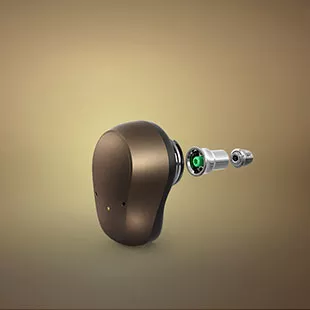At Horend Goed, we help people every day who find that their hearing is not what it used to be. Sometimes it creeps in slowly – you may hear the television a little louder, miss snippets of conversation, or not recognize the direction of sound properly anymore. To properly understand what’s going on, it’s helpful to know exactly how hearing works and what happens when that process gets disrupted.
In this article we explain in an understandable way how the ear picks up sound, what the different forms of hearing loss are and what solutions exist today.
How does our hearing work?
Hearing is a clever interplay of three parts: the external ear, the middle ear and the inner ear.
- The external ear captures sound waves. The auricle and ear canal ensure that sound is naturally amplified and directed toward the eardrum.
- The middle ear begins at the eardrum. This vibrates along with the sound and transmits the vibrations to three tiny bones: the hammer, anvil and stirrup. These amplify the sound and transmit it to the inner ear.
- The inner ear (cochlea or cochlea) converts vibrations into electrical signals. These signals are sent via the auditory nerve to the brain, where they are “translated” into recognizable sounds: speech, music, traffic, birds – everything we hear in our daily lives.
If one of these parts is not working properly, sound can no longer be transmitted properly and we speak of hearing loss.
Different types of hearing loss
There are several types of hearing loss, depending on where in the ear the problem is located. Broadly speaking, we distinguish three forms:
1. Conductivity loss
With conductive hearing loss, sound is not transmitted properly through the external or middle ear.
This can be due to earwax, a middle ear infection, damage to the eardrum or the ossicles, for example. The sound then comes in, but too weakly – as if someone is talking with a hand over the ear.
2. Perceptive hearing loss
In this form, the cause is in the inner ear or the auditory nerve. The cilia in the cochlea, which convert sound vibrations into signals for the brain, are then damaged. This is the most common form of hearing loss and often results from aging, prolonged exposure to noise or hereditary factors.
People with sensorineural hearing loss experience that they can still hear others talking, but do not understand the words well. It sounds like everything is mixed up, especially in company.
3. Mixed hearing loss
Sometimes there is a combination of both. The sound is then both not properly transmitted and not properly processed. In that case, customization is needed to support the hearing as well as possible.
How do you know if you have hearing loss?
Many people do not notice hearing loss until late. It often begins subtly:
- You ask for repetition more often (“What do you say?”)
- The television or radio is a little louder
- You hear sound but do not understand the words well
- Conversations in a group cost more energy
- You hear whistling or whistling (tinnitus)
Do you recognize this? Then it is wise to have a hearing test done. At Horend Goed we measure hearing at different pitches and see exactly where the threshold lies. This way we can determine whether there is mild, moderate or severe hearing loss and what the best solution is.
The brain’s role in hearing
Many people think hearing happens only in the ear, but most of the work takes place in the brain. Your brain must recognize, differentiate and give meaning to the incoming signals. When the ear works less well, the brain receives too little or distorted information. This makes listening more difficult – you have to concentrate more, get tired faster and sometimes feel like you are “off” in a conversation.
Good hearing solutions are aimed precisely at reducing this strain. They not only amplify sound, but also make it clearer and more natural, so your brain doesn’t have to work as hard.
Modern hearing solutions
Today’s technology goes far beyond “just amplification.” Modern hearing aids and implants are tiny computers that analyze sound and automatically adapt to the environment. This makes a big difference in everyday life.
Hearing aids
For most forms of hearing loss, hearing aids offer an excellent solution. They come in a variety of designs: behind-the-ear, in-the-ear or even nearly invisible.
Key Benefits:
- Automatic adaptation to environment: quiet, busy, outdoors or indoors.
- Targeted speech amplification: voices become clearer, background noise softer.
- Wireless connection to phone or TV via Bluetooth.
- Rechargeable batteries, so no fiddling with small button cells.
Bone anchored systems

In some forms of hearing loss – for example, if the middle ear is damaged – sound can be conducted through the bone instead of the ear canal.
A so-called bone anchored hearing system converts sound into vibrations that travel directly through the skull bone to the inner ear.
This technique is ideal for people in whom ordinary hearing aids do not produce adequate results, for example, with chronic ear infections or a closure of the ear canal.
What does this mean in everyday life?
The goal of any hearing solution is simple: to make less effort to hear.
Whether you’re having a conversation with family, watching television or cycling outside – a properly adjusted hearing aid allows sound to come in naturally, so you can focus on what’s important.
Many users find after a short period of habituation that they become less tired and more relaxed participating in conversations. It is not just a technical aid, but a piece of quality of life that comes back.
What can you do yourself?
- Have your hearing checked annually, especially if you notice that understanding becomes more difficult.
- Avoid prolonged exposure to loud noise.
- Do not clean your ears with cotton swabs – this can actually cause damage.
- Clean your hearing aids regularly and use them daily so that your brain continues to get used to the improved sound.
The right solution starts with good advice
Every form of hearing loss is different. That’s why at Horend Goed we always take the time to listen to your experiences and wishes. We do a comprehensive hearing measurement, discuss the results and let you hear and feel different options.
Whether it’s a discreet in-the-ear device, a powerful behind-the-ear model or a sophisticated system that automatically adjusts – the important thing is that it fits you.
Hearing is personal. And we are happy to help you make it as comfortable as possible again.
Want to know more?
Do you feel that your hearing is deteriorating, or would you just like to have a non-committal measurement of your hearing?
Because better hearing starts with attention – and we like to take the time for that.









You must be logged in to post a comment.